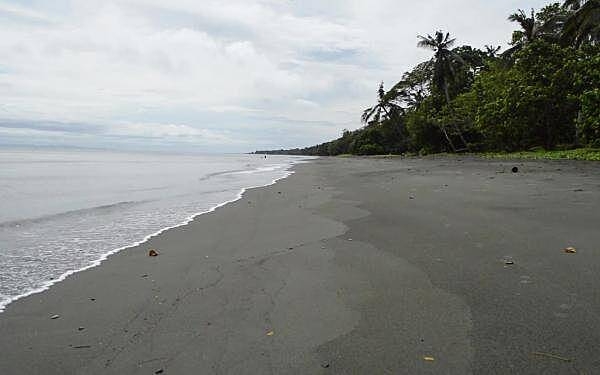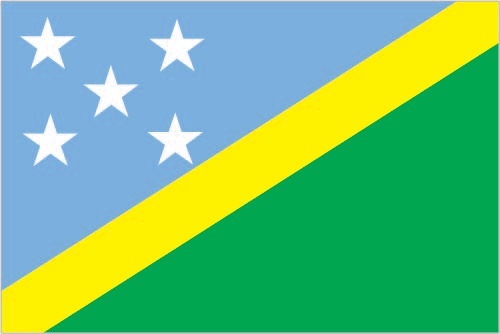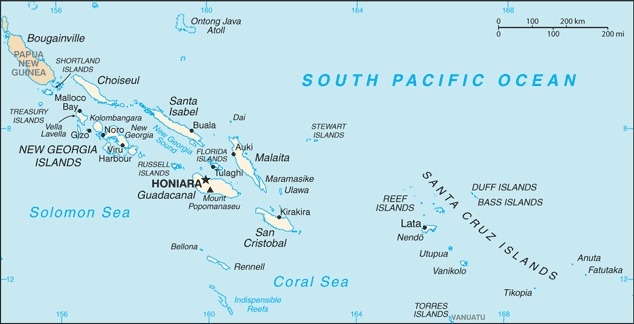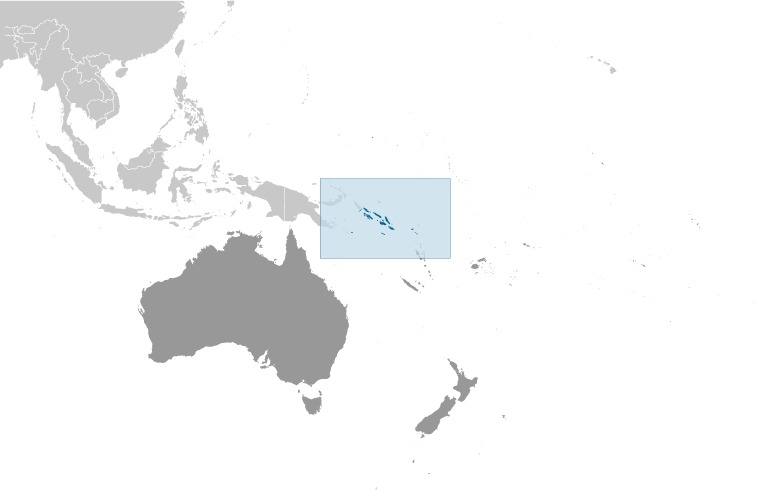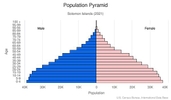Solomon Islands
Introduction
Background
Settlers from Papua arrived on Solomon Islands around 30,000 years ago. About 6,000 years ago, Austronesian settlers came to Solomon Islands and the two groups mixed extensively. Despite significant inter-island trade, no attempts were made to unite the islands into a single political entity. In 1568, Spanish explorer Alvaro de MENDANA became the first European to spot the islands. After a failed Spanish attempt at creating a permanent European settlement on the islands in the late 1500s, Solomon Islands remained free of European contact until 1767 when British explorer Philip CARTERET sailed by the islands. The islands were regularly visited by European explorers and American and British whaling ships into the 1800s, followed by missionaries in the 1850s.
Germany declared a protectorate over the northern Solomon Islands in 1885 and the UK established a protectorate over the southern islands in 1893. In 1899, Germany transferred its Solomon Islands to the UK in exchange for the UK relinquishing all claims in Samoa. The UK tried to encourage plantation farming but few Europeans were willing to go to Solomon Islands and the UK left most services - such as education and medical services - to missionaries. In 1942, Japan invaded Solomon Islands and significant battles against Allied forces during the Guadalcanal Campaign proved a turning point in the Pacific war. World War II destroyed large parts of Solomon Islands and a nationalism movement emerged near the end of the war. By 1960, the British relented to allow for some local autonomy. The islands were granted self-government in 1976 and independence two years later under Prime Minister Sir Peter KENILOREA.
In 1999, longstanding ethnic tensions between ethnic Guale in Honiara and ethnic Malaitans in Honiara’s suburbs erupted in civil war, leading thousands of Malaitans to take refuge in Honiara and Guale to flee the city. In 2000, newly-elected Prime Minister Manasseh SOGAVARE focused on peace agreements and distributing resources equally among groups, but his actions bankrupted the government in 2001 and led to SOGAVARE’s ouster. In 2003, Solomon Islands requested international assistance to reestablish law and order. The Australian-led Regional Assistance Mission to the Solomon Islands (RAMSI), which ended in 2017, was generally effective in improving the security situation. In 2006, riots broke out in Honiara and the city’s Chinatown burned over allegations that the prime minister took money from China. SOGAVARE was reelected prime minister for a fourth time following elections in 2019 and that same year announced Solomon Islands would switch diplomatic recognition from Taiwan to China.
Visit the Definitions and Notes page to view a description of each topic.
Geography
Location
Oceania, group of islands in the South Pacific Ocean, east of Papua New Guinea
Geographic coordinates
8 00 S, 159 00 E
Map references
Oceania
Area - comparative
slightly smaller than Maryland
Land boundaries
total: 0 km
Coastline
5,313 km
Maritime claims
territorial sea: 12 nm
exclusive economic zone: 200 nm
continental shelf: 200 nm
measured from claimed archipelagic baselines
Climate
tropical monsoon; few temperature and weather extremes
Terrain
mostly rugged mountains with some low coral atolls
Elevation
highest point: Mount Popomanaseu 2,335 m
lowest point: Pacific Ocean 0 m
Natural resources
fish, forests, gold, bauxite, phosphates, lead, zinc, nickel
Land use
agricultural land: 3.9% (2018 est.)
arable land: 0.7% (2018 est.)
permanent crops: 2.9% (2018 est.)
permanent pasture: 0.3% (2018 est.)
forest: 78.9% (2018 est.)
other: 17.2% (2018 est.)
Irrigated land
0 sq km NA (2012)
Population distribution
most of the population lives along the coastal regions; about one in five live in urban areas, and of these some two-thirds reside in Honiara, the largest town and chief port
Natural hazards
tropical cyclones, but rarely destructive; geologically active region with frequent earthquakes, tremors, and volcanic activity; tsunamis
volcanism: Tinakula (851 m) has frequent eruption activity, while an eruption of Savo (485 m) could affect the capital Honiara on nearby Guadalcanal
Geography - note
strategic location on sea routes between the South Pacific Ocean, the Solomon Sea, and the Coral Sea
People and Society
Nationality
noun: Solomon Islander(s)
adjective: Solomon Islander
Ethnic groups
Melanesian 95.3%, Polynesian 3.1%, Micronesian 1.2%, other 0.3% (2009 est.)
Languages
Melanesian pidgin (in much of the country is lingua franca), English (official but spoken by only 1%-2% of the population), 120 indigenous languages
Religions
Protestant 73.4% (Church of Melanesia 31.9%, South Sea Evangelical 17.1%, Seventh Day Adventist 11.7%, United Church 10.1%, Christian Fellowship Church 2.5%), Roman Catholic 19.6%, other Christian 2.9%, other 4%, unspecified 0.1% (2009 est.)
Age structure
0-14 years: 32.99% (male 116,397/female 109,604)
15-24 years: 19.82% (male 69,914/female 65,874)
25-54 years: 37.64% (male 131,201/female 126,681)
55-64 years: 5.04% (male 17,844/female 16,704)
65 years and over: 4.51% (male 14,461/female 16,417) (2020 est.)
Dependency ratios
total dependency ratio: 77.6
youth dependency ratio: 71.1
elderly dependency ratio: 6.5
potential support ratio: 15.3 (2020 est.)
Median age
total: 23.5 years
male: 23.2 years
female: 23.7 years (2020 est.)
Population distribution
most of the population lives along the coastal regions; about one in five live in urban areas, and of these some two-thirds reside in Honiara, the largest town and chief port
Urbanization
urban population: 25.1% of total population (2021)
rate of urbanization: 3.57% annual rate of change (2020-25 est.)
Major urban areas - population
82,000 HONIARA (capital) (2018)
Sex ratio
at birth: 1.05 male(s)/female
0-14 years: 1.06 male(s)/female
15-24 years: 1.06 male(s)/female
25-54 years: 1.04 male(s)/female
55-64 years: 1.07 male(s)/female
65 years and over: 0.88 male(s)/female
total population: 1.04 male(s)/female (2020 est.)
Mother's mean age at first birth
22.6 years (2015 est.)
note: median age at first birth among women 25-29
Maternal mortality ratio
104 deaths/100,000 live births (2017 est.)
country comparison to the world: 69Infant mortality rate
total: 20.52 deaths/1,000 live births
male: 24.49 deaths/1,000 live births
female: 16.36 deaths/1,000 live births (2021 est.)
Life expectancy at birth
total population: 76.45 years
male: 73.78 years
female: 79.25 years (2021 est.)
Contraceptive prevalence rate
29.3% (2015)
Drinking water source
improved: urban: 95% of population
rural: 67.1% of population
total: 73.6% of population
unimproved: urban: 5% of population
rural: 32.9% of population
total: 26.4% of population (2017 est.)
Current Health Expenditure
4.5% (2018)
Physicians density
0.19 physicians/1,000 population (2016)
Hospital bed density
1.4 beds/1,000 population (2012)
Sanitation facility access
improved: urban: 95.6% of population
rural: 22% of population
total: 39.1% of population
unimproved: urban: 4.4% of population
rural: 78% of population
total: 60.9% of population (2017 est.)
Major infectious diseases
degree of risk: high (2020)
food or waterborne diseases: bacterial diarrhea
vectorborne diseases: malaria
Unemployment, youth ages 15-24
total: 1.3%
male: 1%
female: 1.6% (2013)
Environment
Environment - current issues
deforestation; soil erosion; many of the surrounding coral reefs are dead or dying; effects of climate change and rising sea levels
Environment - international agreements
party to: Biodiversity, Climate Change, Climate Change-Kyoto Protocol, Climate Change-Paris Agreement, Desertification, Endangered Species, Environmental Modification, Law of the Sea, Marine Dumping-London Convention, Marine Life Conservation, Ozone Layer Protection, Ship Pollution, Whaling
signed, but not ratified: Comprehensive Nuclear Test Ban
Air pollutants
particulate matter emissions: 10.67 micrograms per cubic meter (2016 est.)
carbon dioxide emissions: 0.17 megatons (2016 est.)
methane emissions: 0.43 megatons (2020 est.)
Climate
tropical monsoon; few temperature and weather extremes
Land use
agricultural land: 3.9% (2018 est.)
arable land: 0.7% (2018 est.)
permanent crops: 2.9% (2018 est.)
permanent pasture: 0.3% (2018 est.)
forest: 78.9% (2018 est.)
other: 17.2% (2018 est.)
Urbanization
urban population: 25.1% of total population (2021)
rate of urbanization: 3.57% annual rate of change (2020-25 est.)
Revenue from forest resources
forest revenues: 20.27% of GDP (2018 est.)
country comparison to the world: 1Major infectious diseases
degree of risk: high (2020)
food or waterborne diseases: bacterial diarrhea
vectorborne diseases: malaria
Waste and recycling
municipal solid waste generated annually: 179,972 tons (2013 est.)
Total renewable water resources
44.7 billion cubic meters (2017 est.)
Government
Country name
conventional long form: none
conventional short form: Solomon Islands
local long form: none
local short form: Solomon Islands
former: British Solomon Islands
etymology: Spanish explorer Alvaro de MENDANA named the isles in 1568 after the wealthy biblical King SOLOMON in the mistaken belief that the islands contained great riches
Government type
parliamentary democracy under a constitutional monarchy; a Commonwealth realm
Capital
name: Honiara
geographic coordinates: 9 26 S, 159 57 E
time difference: UTC+11 (16 hours ahead of Washington, DC, during Standard Time)
etymology: the name derives from "nagho ni ara," which in one of the Guadalcanal languages roughly translates as "facing the eastern wind"
Administrative divisions
9 provinces and 1 city*; Central, Choiseul, Guadalcanal, Honiara*, Isabel, Makira and Ulawa, Malaita, Rennell and Bellona, Temotu, Western
Independence
7 July 1978 (from the UK)
National holiday
Independence Day, 7 July (1978)
Constitution
history: adopted 31 May 1978, effective 7 July 1978; note - in late 2017, provincial leaders agreed to adopt a new federal constitution, with passage expected in 2018, but it has been postponed indefinitely
amendments: proposed by the National Parliament; passage of constitutional sections, including those on fundamental rights and freedoms, the legal system, Parliament, alteration of the constitution and the ombudsman, requires three-fourths majority vote by Parliament and assent of the governor general; passage of other amendments requires two-thirds majority vote and assent of the governor general; amended several times, last in 2018; note - a new constitution was drafted in mid-2009 and the latest version drafted in 2013
Legal system
mixed legal system of English common law and customary law
International law organization participation
has not submitted an ICJ jurisdiction declaration; non-party state to the ICCt
Citizenship
citizenship by birth: no
citizenship by descent only: at least one parent must be a citizen of the Solomon Islands
dual citizenship recognized: no
residency requirement for naturalization: 7 years
Suffrage
21 years of age; universal
Executive branch
chief of state: Queen ELIZABETH II (since 6 February 1952); represented by Governor General David VUNAGI (since 8 July 2019)
head of government: Prime Minister Rick HOU (since 16 November 2017)
cabinet: Cabinet appointed by the governor general on the advice of the prime minister
elections/appointments: the monarchy is hereditary; governor general appointed by the monarch on the advice of the National Parliament for up to 5 years (eligible for a second term); following legislative elections, the leader of the majority party or majority coalition usually elected prime minister by the National Parliament; deputy prime minister appointed by the governor general on the advice of the prime minister from among members of the National Parliament
election results: Manasseh SOGAVARE (independent) defeated in no-confidence vote on 6 November 2017; Rick HOU elected prime minister on 15 November 2017
Legislative branch
description: unicameral National Parliament (50 seats; members directly elected in single-seat constituencies by simple majority vote to serve 4-year terms)
elections: last held on 3 April 2019 (next to be held in 2023)
election results: percent of vote by party - UDP 10.7%, DAP 7.8%, PAP 4.4%, other 20.8%, independent 56.3%; seats by party - DAP 7, UDP 5, PAP 3, KPSI 1, SIPFP 1, SIPRA 1, independent 32; composition - men 49, women 1, percent of women 2%
Judicial branch
highest courts: Court of Appeal (consists of the court president and ex officio members including the High Court chief justice and its puisne judges); High Court (consists of the chief justice and puisne judges, as prescribed by the National Parliament)
judge selection and term of office: Court of Appeal and High Court president, chief justices, and puisne judges appointed by the governor general upon recommendation of the Judicial and Legal Service Commission, chaired by the chief justice and includes 5 members, mostly judicial officials and legal professionals; all judges serve until retirement at age 60
subordinate courts: Magistrates' Courts; Customary Land Appeal Court; local courts
Political parties and leaders
Democratic Alliance Party or DAP [Steve ABANA]
Kadere Party of Solomon Islands or KPSI [Peter BOYERS]
People's Alliance Party or PAP [Nathaniel WAENA]
Solomon Islands People First Party or SIPFP [Dr. Jimmie RODGERS]
Solomon Islands Party for Rural Advancement or SIPRA [Manasseh MAELANGA]
United Democratic Party or UDP [Sir Thomas Ko CHAN]
note: in general, Solomon Islands politics is characterized by fluid coalitions
International organization participation
ACP, ADB, AOSIS, C, EITI (candidate country), ESCAP, FAO, G-77, IBRD, ICAO, ICRM, IDA, IFAD, IFC, IFRCS, ILO, IMF, IMO, IOC, ITU, MIGA, OPCW, PIF, Sparteca, SPC, UN, UNCTAD, UNESCO, UPU, WFTU, WHO, WMO, WTO
Diplomatic representation in the US
chief of mission: Ambassador (vacant); Charge d'Affaires Janice Mose KEMAKEZA
chancery: 685 Third Avenue, 11th Floor, Suite 1102, New York, NY 10017
telephone: [1] (212) 599-6192; [1] (212) 599-6193
FAX: [1] (212) 661-8925
email address and website:
simun@solomons.com
Diplomatic representation from the US
embassy: the US does not have an embassy in the Solomon Islands; the US Ambassador to Papua New Guinea is accredited to the Solomon Islands
Flag description
divided diagonally by a thin yellow stripe from the lower hoist-side corner; the upper triangle (hoist side) is blue with five white five-pointed stars arranged in an X pattern; the lower triangle is green; blue represents the ocean, green the land, and yellow sunshine; the five stars stand for the five main island groups of the Solomon Islands
National symbol(s)
national colors: blue, yellow, green, white
National anthem
name: God Save Our Solomon Islands
lyrics/music: Panapasa BALEKANA and Matila BALEKANA/Panapasa BALEKANA
note: adopted 1978
Economy
Economic overview
The bulk of the population depends on agriculture, fishing, and forestry for at least part of its livelihood. Most manufactured goods and petroleum products must be imported. The islands are rich in undeveloped mineral resources such as lead, zinc, nickel, and gold. Prior to the arrival of The Regional Assistance Mission to the Solomon Islands (RAMSI), severe ethnic violence, the closure of key businesses, and an empty government treasury culminated in economic collapse. RAMSI's efforts, which concluded in Jun 2017, to restore law and order and economic stability have led to modest growth as the economy rebuilds.
Real GDP (purchasing power parity)
$1.71 billion note: data are in 2017 dollars (2020 est.)
$1.78 billion note: data are in 2017 dollars (2019 est.)
$1.76 billion note: data are in 2017 dollars (2018 est.)
note: data are in 2017 dollars
Real GDP growth rate
3.5% (2017 est.)
3.5% (2016 est.)
2.5% (2015 est.)
Real GDP per capita
$2,500 note: data are in 2017 dollars (2020 est.)
$2,700 note: data are in 2017 dollars (2019 est.)
$2,700 note: data are in 2017 dollars (2018 est.)
note: data are in 2017 dollars
GDP (official exchange rate)
$1.298 billion (2017 est.)
Credit ratings
Moody's rating: B3 (2015)
GDP - composition, by sector of origin
agriculture: 34.3% (2017 est.)
industry: 7.6% (2017 est.)
services: 58.1% (2017 est.)
GDP - composition, by end use
household consumption: NA
government consumption: NA
investment in fixed capital: NA
investment in inventories: NA
exports of goods and services: 25.8% (2011 est.)
imports of goods and services: -49.6% (2011 est.)
Agricultural products
oil palm fruit, sweet potatoes, coconuts, taro, yams, fruit, pulses nes, vegetables, cocoa, cassava
Industries
fish (tuna), mining, timber
Labor force - by occupation
agriculture: 75%
industry: 5%
services: 20% (2000 est.)
Population below poverty line
12.7% (2012 est.)
Gini Index coefficient - distribution of family income
37.1 (2013 est.)
country comparison to the world: 82Household income or consumption by percentage share
lowest 10%: NA
highest 10%: NA
Budget
revenues: 532.5 million (2017 est.)
expenditures: 570.5 million (2017 est.)
Fiscal year
calendar year
Current account balance
-$54 million (2017 est.)
-$49 million (2016 est.)
Exports
$430 million note: data are in current year dollars (2020 est.)
$590 million note: data are in current year dollars (2019 est.)
$680 million note: data are in current year dollars (2018 est.)
Exports - partners
China 65%, Italy 9%, India 6% (2019)
Exports - commodities
lumber, fish, aluminum, palm oil, cocoa beans (2019)
Imports
$560 million note: data are in current year dollars (2020 est.)
$750 million note: data are in current year dollars (2019 est.)
$750 million note: data are in current year dollars (2018 est.)
Imports - partners
China 24%, Australia 13%, South Korea 12%, Singapore 12%, Malaysia 10% (2019)
Imports - commodities
refined petroleum, fish, insulated wiring, broadcasting equipment, excavation machinery (2019)
Reserves of foreign exchange and gold
$0 (31 December 2017 est.)
$421 million (31 December 2016 est.)
Debt - external
$757 million (31 December 2017 est.)
$643 million (31 December 2016 est.)
Exchange rates
Solomon Islands dollars (SBD) per US dollar -
8.06126 (2020 est.)
8.10373 (2019 est.)
8.01282 (2018 est.)
7.9147 (2014 est.)
7.3754 (2013 est.)
Unemployment, youth ages 15-24
total: 1.3%
male: 1%
female: 1.6% (2013)
Energy
Electricity access
electrification - total population: 66.7% (2018)
electrification - urban areas: 76.7% (2018)
electrification - rural areas: 63.5% (2018)
Electricity - installed generating capacity
38,000 kW (2016 est.)
country comparison to the world: 197Electricity - from fossil fuels
92% of total installed capacity (2016 est.)
country comparison to the world: 52Electricity - from nuclear fuels
0% of total installed capacity (2017 est.)
country comparison to the world: 184Electricity - from hydroelectric plants
0% of total installed capacity (2017 est.)
country comparison to the world: 201Electricity - from other renewable sources
8% of total installed capacity (2017 est.)
country comparison to the world: 89Refined petroleum products - consumption
1,600 bbl/day (2016 est.)
country comparison to the world: 198Communications
Telephones - fixed lines
total subscriptions: 7,104 (2019)
subscriptions per 100 inhabitants: 1.06 (2019 est.)
Telephones - mobile cellular
total subscriptions: 478,116 (2019)
subscriptions per 100 inhabitants: 71.38 (2019 est.)
Telecommunication systems
general assessment: Internet penetration has reached 20%; 3G and 4G LTE mobile network expansions, investment in mobile services in the region; otherwise 3G and satellite services for communication and Internet access; increase in broadband subscriptions; the launch of the Kacific-1 satellite in 2019 and the Coral Sea Cable System have vastly improved the telecom sector (2020)
domestic: fixed-line is 1 per 100 persons and mobile-cellular telephone density is about 71 per 100 persons; domestic cable system to extend to key major islands (2019)
international: country code - 677; landing points for the CSCS and ICNS2 submarine cables providing connectivity from Solomon Islands, to PNG, Vanuatu and Australia; satellite earth station - 1 Intelsat (Pacific Ocean) (2019)
note: the COVID-19 pandemic continues to have a significant impact on production and supply chains globally; since 2020, some aspects of the telecom sector have experienced downturn, particularly in mobile device production; many network operators delayed upgrades to infrastructure; progress towards 5G implementation was postponed or slowed in some countries; consumer spending on telecom services and devices was affected by large-scale job losses and the consequent restriction on disposable incomes; the crucial nature of telecom services as a tool for work and school from home became evident, and received some support from governments
Broadcast media
Solomon Islands Broadcasting Corporation (SIBC) does not broadcast television; multi-channel pay-TV is available; SIBC operates 2 national radio stations and 2 provincial stations; there are 2 local commercial radio stations; Radio Australia is available via satellite feed (since 2009) (2019)
Internet users
total: 198,900 (2021 est.)
percent of population: 11.92% (2019 est.)
Broadband - fixed subscriptions
total: 1,045 (2019)
subscriptions per 100 inhabitants: less than 1 (2019 est.)
Transportation
National air transport system
number of registered air carriers: 1 (2020)
inventory of registered aircraft operated by air carriers: 6
annual passenger traffic on registered air carriers: 427,806 (2018)
annual freight traffic on registered air carriers: 3.84 million mt-km (2018)
Airports - with paved runways
total: 1
1,524 to 2,437 m: 1 (2019)
Airports - with unpaved runways
total: 35
1,524 to 2,437 m: 1
914 to 1,523 m: 10
under 914 m: 24 (2013)
Heliports
3 (2013)
Roadways
total: 1,390 km (2011)
paved: 34 km (2011)
unpaved: 1,356 km (2011)
note: includes 920 km of private plantation roads
Merchant marine
total: 24
by type: general cargo 8, oil tanker 1, other 15 (2021)
Ports and terminals
major seaport(s): Honiara, Malloco Bay, Viru Harbor, Tulagi
Military and Security
Military and security forces
no regular military forces; the Royal Solomon Islands Police is responsible for internal and external security and reports to the Ministry of Police, National Security, and Correctional Services
Military equipment inventories and acquisitions
the maritime branch of the Royal Solomon Islands Police Force operates patrol boats provided by Australia (2021)
Military - note
Australia and New Zealand provide material and training assistance to the police
Transnational Issues
Disputes - international
since 2003, the Regional Assistance Mission to Solomon Islands, consisting of police, military, and civilian advisors drawn from 15 countries, has assisted in reestablishing and maintaining civil and political order while reinforcing regional stability and security
